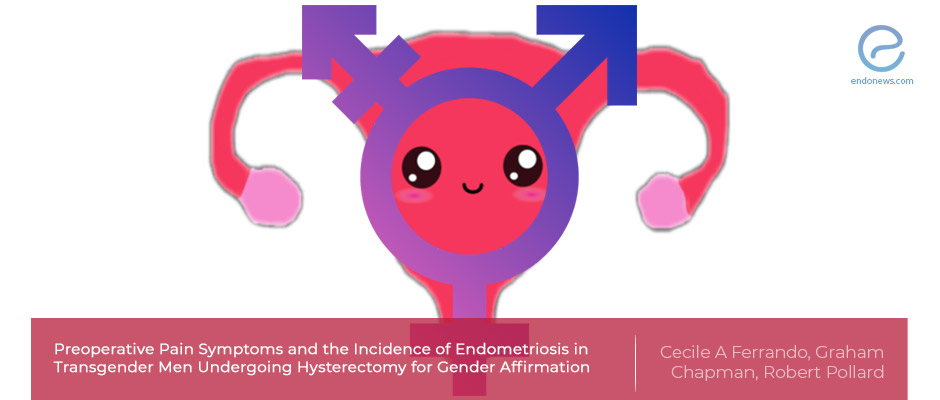The incidence of endometriosis and pelvic pain in transgender man
Mar 5, 2021
The prevalence of endometriosis and pelvic pain higher in the gender affirmation population
Key Points
Highlights:
- Pelvic pain complaints were found to be higher in the transgender population, and 1 out of 3 had endometriosis not affected by testosterone use.
Importance:
- This is the first study analyzing endometriosis in transgender men.
What's done here:
- The records of 67 patients who had hysterectomy for gender affirmation were evaluated.
- Endometriosis was diagnosed during surgery and the preference for biopsy was left to surgeons’ decision.
- The history for pelvic pain, dysmenorrhea, heavy menses, or irregular menses and their relations with testosterone use was also noted.
Key Results:
- A total of 67 patients were evaluated.
- 89.5% were on testosterone, 59.7% reported amenorrhea, 43.2% had dysmenorrhea and 17.9% had heavy menses, 50.7% reported pelvic pain.
- Intraoperatively endometriosis was visualized in one third of the patients, and 70% of them were in stage I or II. Histopathological confirmation of endometriosis was possible 80%.
- Out of patients who represented with pelvic pain 32.3% were found to have endometriosis, while 22% without any pain were also found to have endometriotic foci.
- The only symptoms that statistically differed between endometriotic and non-endometriotic patients were irregular and heavy menses.
- Neither heavy bleeding nor pelvic pain changed regarding testosterone use.
Strength and Limitations:
- The reliabillty of electronic medical records and apropriate scientific definitions for the variables were strengths of the study.
- The study was conducted retrospectively, and the visualization of endometriosis was not always confirmed by hisopathological diagnosis. Also, some cases could be missed, hence the incidence of endometriosis may either be an under- or overestimation of the true incidence.
Lay Summary
Transgender operations are quite common all around the world and hysterectomies are performed almost 1 in 5 of this population. The studies conducted until now mostly evaluated operative and postoperative outcomes, but the present research also questioned the preoperative symptoms and their relationship with operative findings.
Dr. Ferrando et al. from the Center for Urogynecology & Pelvic Reconstructive Surgery, S and Center for LGBT+ Care, Cleveland Clinic, analyzed a ten-year data retrospectively and examined the symptoms related to menstrual disorders and pelvic pain. The data of 67 patients fulfilled the inclusion criteria. Although almost 90% were under testosterone treatment, the pain symptoms and the visualization of endometriotic lesions was not different from those who do not use testosterone. Intraoperatively endometriosis was visualized in 27%.
Among the patients who presented with pelvic pain, 32% were found to have endometriosis, while this figure was 22% for those without any pain.
The only statistically different symptoms between endometriotic and non-endometriotic patients were irregular and heavy bleeding.
The authors concluded that transgender men may have endometriosis, the incidence of menstrual disorders and pelvic pain is high, and the disease should be managed properly.
This interesting paper will be published in the "Journal of Minimally Invasive Gynecology" soon.
Research Source: https://pubmed.ncbi.nlm.nih.gov/33497725/
transgender men endometriosis pelvic pain

